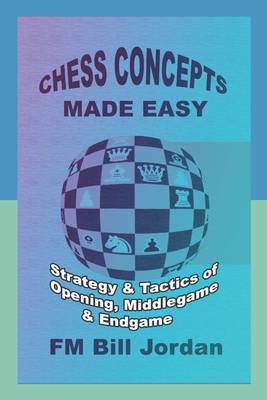
- Afhalen na 1 uur in een winkel met voorraad
- Gratis thuislevering in België vanaf € 30
- Ruim aanbod met 7 miljoen producten
- Afhalen na 1 uur in een winkel met voorraad
- Gratis thuislevering in België vanaf € 30
- Ruim aanbod met 7 miljoen producten
Chess Concepts Made Easy
Strategy and Tactics of Opening, Middlegame and Endgame.
Fm Bill JordanOmschrijving
Chess is a game of ideas. There are many tactical and strategical ideas that can help a player select a move or plan. There are important ideas, concepts, themes and patterns for the opening, middle game and endgame phase. Experienced players develop a very good understanding of many of these.
FIDE Master and Australian correspondence champion Bill Jordan explains many of these ideas using diagrams, text and examples.
This book is designed to be most useful for the bulk of players who are rated between about 1200 and 1800. The aim of the book is to help the reader improve his play by deepening his understanding of chess, though of course it can be purely read for entertainment value. Strong players may find useful ideas which will help them find good moves more quickly. It has been said all grandmasters will find a mate in 8, but some will find it more quickly than others. The quicker you find good moves, the better.
For maximum benefit, reread the book several times. On subsequent readings you will grasp points that were previously obscure to you and your understanding will be deepened. Its not critical to read it in any particular order.
Emanuel Lasker once claimed he could take a young man of average ability and coach him to candidate master strength (about 2000 ELO) in the space of about 120 hours. Although this has not been proven possible, he has made a valid point that many people learn chess in a haphazard fashion and don't make the best use of their chess learning time. A good aim is to learn as much as you can with the time you can allow for chess.
The book will cover material that the reader doubtless has some familiarity with already. Some prior knowledge is presumed and the reader will be reinforcing and building on what is already understood. Hopefully though, it will help you look at things in a different light.
This knowledge can be very useful. By comparing the current position in your game with known precedents, you can come up with the right plan.
But what if you don't know a familiar precedent? What you need, is a plastic method that can be applied to any situation. One chapter concentrates on the method that is used to select a move. The method will alter according to circumstances, particularly in the endgame, but can be useful in all situations. There are 2 basic aims in chess are:
- To checkmate the King.
- To avoid being checkmated.
- TACTICS describes the common types of tactical devices and many tactical concepts.
- POSITIONAL PLAY describes many positional concepts.
- ENDGAMES describes endgame concepts and many of the more common endings.
- OPENINGS describes opening concepts.
- THE METHOD discusses approaches to selecting a move.
- PRACTICAL PLAY discusses practical play.
See my authors page for information about my background and other books.
Specificaties
Betrokkenen
- Auteur(s):
- Uitgeverij:
Inhoud
- Aantal bladzijden:
- 204
- Taal:
- Engels
Eigenschappen
- Productcode (EAN):
- 9781790230389
- Verschijningsdatum:
- 27/11/2018
- Uitvoering:
- Paperback
- Formaat:
- Trade paperback (VS)
- Afmetingen:
- 152 mm x 229 mm
- Gewicht:
- 303 g

Alleen bij Standaard Boekhandel
Beoordelingen
We publiceren alleen reviews die voldoen aan de voorwaarden voor reviews. Bekijk onze voorwaarden voor reviews.











